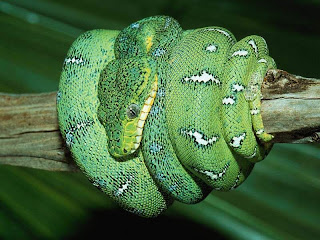Animal Wildlife | Snake | Snake is any of the numerous elongate, limbless, scaled, carnivorous reptiles comprising the suborder Serpentes (or Ophidia) of the order Squamata. Snakes generally are distinguished from lizards - which also belong to order Squamata, but are placed in suborder Sauria (or Lacertilia) - by the absence of legs, although some lizards are legless. Snakes are also differentiated from lizards by have more flexible jaws and by lacking external ear openings and movable eyelids whereas most lizards (but not all) have movable eyelids and external ear openings.There are around 2,700 known species of snake worldwide,with the snake being found on every continent apart from the polar regions,where it is too cold for the snake.
The snake can grow anywhere from 10cm in length, to the enormous anaconda snake that can reach lengths of up to 30ft long! There are two ways that snakes kill their prey, either the snake has a poisonous bite or the snake will wrap itself around the prey to constrict it.
Of the twenty biological families of snakes, three are known to be venomous (Elapidae, Viperidae, Atractaspididae) with some venomous members found in a fourth family (Colubridae), although there are indications venomous snakes may be more common than previously thought (Fry et al. 2006). Although the majority of venomous snakes are small innocuous creatures, many are capable of causing painful injury or death to humans. Venom in snakes is more for killing and subduing prey than it is for self-defense.
Most species of snake inhabiting colder regions in the Northern Hemisphere,will hibernate through the cold winter months.The snake tends to mate in the spring time. A literary word for snake is serpent. In modern usage, the term serpent usually refers to a mythic or symbolic snake. In Christianity, the serpent is often identified with the devil, as in the Biblical account of Adam and Eve. Serpent is a Middle English word that comes from Old French, and ultimately from *serp-, "to creep".
Although snakes in some cultures tend to have an unfavorable reputation,the reality is that they offer important ecological,economic, and symbolic values.Ecologically, they help to maintain the balance of nature,and are important in controlling pest rodents and insects that can damage agricultural crops, infest homes,and serve as vectors of disease.They have served as food and provided snake skin for commercial products.They have also served as symbols throughout history.They have been revered in some historical cultures,such as Ancient Egypt,and even in some present societies,such as India,which is steeped in tradition regarding snakes (Deane 1833).Three important medical symbols involving snakes are used today: the Bowl of Hygieia,symbolizing pharmacy,and the Caduceus and Rod of Asclepius,which are symbols denoting medicine in general.- ANIMAL WILDLIFE
Tags: snake exterminator, snake insurance, snake extermination, plumbing snake rental, snake removal services, drain snake rental, sewer snake camera, sewer drain snake, drain cleaning snake, snake removal, snake plumbing tool, drain snake, sewer snake rental, plumbing drain snake, plumber snake, snake drain, snake for drains, snake for plumbing, plumbers snake, plumber s snake






0 Response to "Snake"
Post a Comment